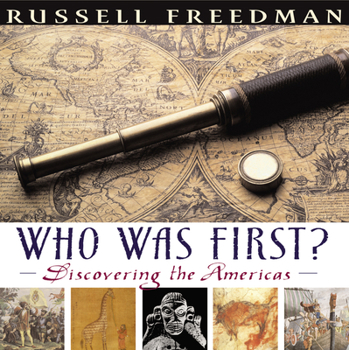Who Was First?: Discovering the Americas
Select Format
Select Condition 
Book Overview
Many generations of American schoolchildren were taught that Columbus discovered America, and a holiday reminds us every October. But historical investigation in recent years has shown us otherwise. There is evidence that adventurers, explorers, traders, and nomads from various parts of the globe set foot on American soil long before 1492. And expeditions that landed in the Americas reported people already living there--indicating that America...
Format:Hardcover
Language:English
ISBN:0618663916
ISBN13:9780618663910
Release Date:October 2007
Publisher:Clarion Books
Length:96 Pages
Weight:1.55 lbs.
Dimensions:0.5" x 9.7" x 9.6"
Age Range:10 to 12 years
Grade Range:Grades 5 to 7
Customer Reviews
2 ratings
history not to be missed
Published by Thriftbooks.com User , 15 years ago
as an elementary teacher and history lover, this book is not to be missed. it is beautifully illustrated and well written. easy for young readers (upper elementary) and engaging enough for adults. intriguing and thorough!
Russel Freedman - concerns
Published by Thriftbooks.com User , 16 years ago
On accuracy: It is wrong to skip or gloss over facts that lead to wrong conclusions. In Russel Freedman's Who was First?, page 11, where he quotes Columbus, "They [the Arawaks] were well built...", Columbus, in that same quote, also wrote in his journal that he took some of the natives by force (2). "They [the Arawaks] would make fine servants . . . With fifty men we could subjugate them all and make them do whatever we want" (1) Russel Freedman's book skips a lot on accuracy for Columbus: "Columbus received 10% of the profits from this venture [and] governship over new found lands..."(2). A man named Rodrigo saw the Americas first, but Columbus claimed he saw the land first and he received the reward of an annual pension of 10,000 maravedis for his lifetime (38 kg = 83.6 lbs of silver or about $22,700 in today's dollars)(3). On Hispaniola Columbus took more prisoners and two Arawaks were bled to death with swords for they had refused to trade the number of bows and arrows Columbus and his men wanted (3). On the second trip, Columbus and 1,200 hundred men rounded up 1,500 Arawak men, women and children for slaves: 500 went back to Spain and 200 died en route (4). On Haiti, the original camp of Spaniards had been destroyed because they took women and children for sex and labor slaves (4). In Haiti, Columbus forced all those 14 an older to collect a specific amount of gold every three months; those who failed had their hands cut off (4). Spaniards would behead Indians for fun. Natives who ran away were hanged or burned, so the Arawak men, women, and children started committing mass suicide with Cassava poison (4). By 1650, all the original Arawaks and descendents were dead (5). Howard Zinn. A People's History of the United States. Russel Freedman fails to name Columbus appropriately as a slaver and an encourager of the rape, genocide and enslavement of the Arawaks. He whitewashes some of the history with his words and pictures (especially priests blessing this man), thereby not giving Columbus his proper due. I did like Russel Freedman's analysis of the flaws in the theories the Chinese were in the Americas well before Columbus (p31-33). I would liked to have seen more writing on the Heyerdahl's 1947 KonTiki expedition that proved Indian balsa wood rafts could cross the Pacific Ocean. The analysis of Viking landings (43) tie in with what I have read before. I wish Africa had been given more attention. I read there are rock carvings in South America that can be traced to African carvings. Still, Accuracy wise, for a children's book, Who was First? breaks new bounds. Jason Penterman, West Bend, WI






